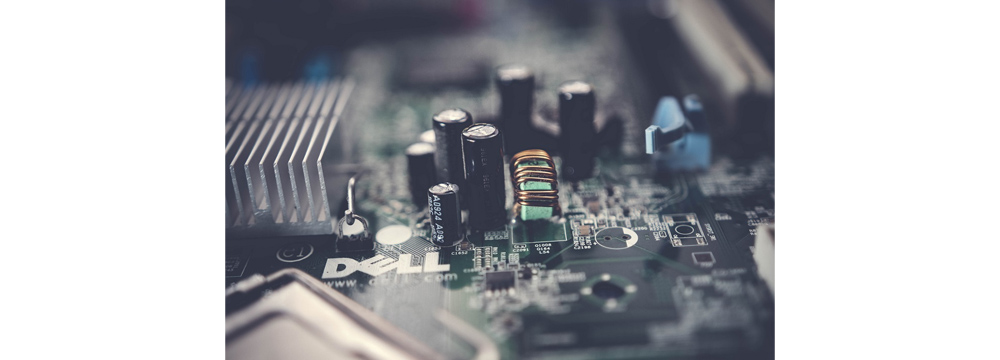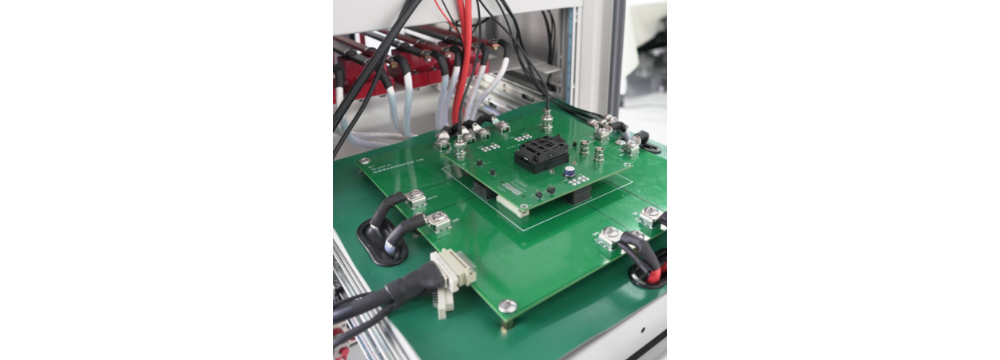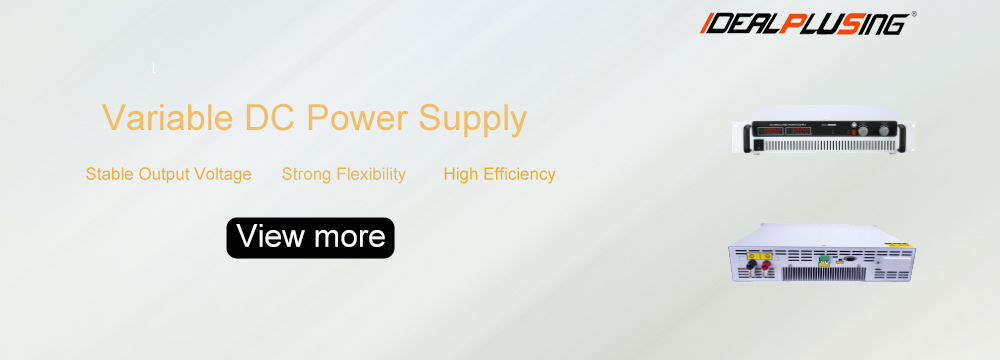What is a programmable power supply?
A programmable power supply is a power supply device that controls output voltage, current and other parameters through computer software programming. It supports constant voltage (CV), constant current (CC), series and parallel working modes, and has advanced functions such as induction compensation and waveform editing. It can achieve remote control through serial communication, accurately set parameter limits and protection mechanisms, and is suitable for precision testing, industrial automation and other fields.
Its working mode
The working mode of the power supply can be divided into constant voltage output mode (CV), constant current output mode (CC), series mode and parallel mode. Among them, in constant voltage mode, the output current of the power supply changes with the load to ensure the constant output voltage. In constant current mode, the output voltage of the power supply changes with the load to ensure the constant output current. The output connection of parallel mode or series mode must be carried out independently, and the output of one power supply device can also be connected to the output of another power supply device. In order to obtain a larger output voltage, the series mode can be adopted, and in order to obtain a larger output current, the parallel mode can be adopted.
(1) Series mode In series mode, due to the addition (or subtraction) of voltages, the maximum current is determined by the power supply device with the smallest set value, so the current of all devices is equal at this time.
(2) Parallel mode In order to increase the total output current, parallel connection can be adopted. At this time, the output voltage of all devices is the same, and the size is determined by the power supply device with the lowest rated output voltage. The total current is the sum of the currents of each parallel branch. If the specifications of the power supply devices used are the same, please check whether the current distributed on each power supply device is even when paralleling. Since the current flowing through each power supply device is the same when paralleling, if other types of power supply devices are used, such voltage may be damaged by the current without overload protection.
To ensure the stability of the output current of the programmable power supply, it is necessary to build a guarantee system from five dimensions: hardware design, parameter configuration, dynamic response optimization, environmental control, monitoring and calibration. Combined with scientific testing methods and standardized operations, the current fluctuation is <0.5% rated value (steady state) and fast recovery (dynamic response time <100μs). The following are specific implementation strategies:

I. Hardware design: Lay a solid foundation for stability
1. Power supply topology Choose linear power supply (LDO): Applicable scenarios: Noise-sensitive loads (such as high-precision ADC, RF circuits), need output current <3A and small voltage difference (such as input 12V → output 5V). Advantages: Very low ripple (<1mV), high current stability (load regulation rate <0.01%/A). Case: When testing a 16-bit ADC, use LDO (such as LT3080) to provide 5V power supply, and the current fluctuation is reduced from 50mA of the switching power supply to 5mA, effectively reducing noise interference. Switching power supply (DC-DC): Applicable scenarios: High current demand (such as motor drive, LED lighting), need output current >3A or large voltage difference (such as input 24V → output 12V). Optimization direction: Synchronous rectification: Use MOSFET instead of diode rectification to reduce conduction loss (efficiency improvement of 5%~10%). Multi-phase parallel connection: Split a single-phase power supply into multiple phases (such as 4 phases), each phase bears part of the current, and reduces the single-phase current stress (such as 100A power supply is split into 4 phases, 25A per phase). 2. Output filter circuit LC filter: Design principle: Inductance (L) value selection: Calculated according to the switching frequency (f_sw) and current ripple (ΔI_L), the formula is L=Vin⋅fsw⋅ΔILVout⋅(Vin−Vout). Capacitor (C) value selection: Calculated according to the ripple voltage (ΔV_out), the formula is C=8⋅fsw⋅ΔVoutΔIL. Example: For a 24V/5A switching power supply (f_sw=200kHz), if ΔI_L<0.5A and ΔV_out<50mV are required, L=12μH and C=100μF are required. Ceramic capacitors and electrolytic capacitors are connected in parallel:
Function: Ceramic capacitors (such as 10μF/50V) suppress high-frequency noise (100kHz~1MHz), and electrolytic capacitors (such as 1000μF/25V) filter low-frequency ripple (<100kHz).
Layout requirements: The capacitor is close to the power output terminal, and the lead is as short as possible (to reduce parasitic inductance).
II. Parameter configuration: Accurately control output characteristics
1. Current mode selection constant current (CC) mode: Applicable scenarios: battery charging, LED constant current drive, material testing (such as resistivity measurement). Setting method: Set the target current (such as 2A) through the power panel or SCPI command (such as CURR 2.0). Enable current loop compensation (such as PID parameter adjustment) to avoid oscillation (overshoot <5%). Case: When charging lithium batteries, set the CC mode current to 1C (such as 2A for a 2000mAh battery), and automatically switch to constant voltage (CV) mode when the voltage rises to 4.2V at the end of charging. Current limit in constant voltage (CV) mode: Applicable scenarios: The power supply is a voltage source, but the maximum output current needs to be limited (such as protecting the load or the power supply itself). Setting method: Set the voltage value (such as 12V), and then set the current upper limit (such as CURR 3.0 current limit 3A). When the load current approaches the current limit value, the power supply automatically switches from CV mode to CC mode, and the output voltage drops to maintain a constant current. 2. Protection parameters coordinated with overcurrent protection (OCP): Threshold setting: Higher than the maximum operating current of the load (such as the normal operating current of the load is 2A, OCP is set to 2.5A, leaving a 25% margin). Lower than the rated current of the power supply (such as the rated 5A of the power supply, OCP≤5A). Delay setting: For dynamic loads (such as motor starting), set a 100ms~500ms delay to avoid false triggering of protection by startup impact. For static loads, set a delay of <10ms to quickly respond to overcurrent faults. The relationship between overvoltage protection (OVP) and current stability:
Principle: OVP triggering will cause the power supply to shut down, indirectly affecting the current output.
Optimization: Ensure that the OVP threshold is higher than the maximum voltage of the load (for example, if the load V_max=12V, OVP is set to 13V) to avoid false triggering due to voltage fluctuations.
III. Dynamic response optimization: Dealing with load mutations
1. Load mutation test method Test tool: Electronic load (such as Chroma 6310A) supports programmable control of current mutations (such as a sudden increase from 0A to 2A, or a sudden decrease from 2A to 0A). Oscilloscope (such as Tektronix MSO64) monitors the output voltage and current waveforms of the power supply (bandwidth ≥ 500MHz, sampling rate ≥ 5GSa/s). Key indicators: Rise time (t_r): The time required for the current to rise from 10% to 90% of the rated value (such as from 0.2A to 2A, t_r < 50μs). Overshoot amplitude (Overshoot): The ratio of the instantaneous peak value when the current suddenly increases to the rated value (such as the peak value < 2.1A when the 2A suddenly increases, that is, the overshoot < 5%). Recovery time (t_s): The time (e.g. <100μs) required for the output voltage/current to recover to the steady-state error band (e.g. ±0.5%) after a sudden change in current. 2. Optimization strategy Adjustment of power supply loop compensation: PID parameter adjustment: Increasing the proportional coefficient (K_p) can speed up the response, but may cause oscillation. Increasing the integral coefficient (K_i) can eliminate the steady-state error, but will prolong the recovery time. Increasing the differential coefficient (K_d) can suppress overshoot, but is sensitive to noise. Case: For the Keysight N6700 series power supply, the parameters are adjusted through the SYST:COMP:PID command to shorten the current rise time from 100μs to 40μs and reduce the overshoot from 10% to 3%. Increase output capacitance: Function: The capacitor stores charge and provides instantaneous current when the load suddenly changes (e.g. a 1000μF capacitor can provide 2A current for 0.5ms). Selection principle:
Low ESR capacitors (e.g. ceramic capacitors) suppress high-frequency oscillations.
High-capacity electrolytic capacitors (e.g. tantalum capacitors) provide low-frequency energy buffering.

IV. Environmental control: Eliminate external interference
1. Heat dissipation design Natural heat dissipation: Ensure good ventilation around the power supply (such as leaving a distance of more than 10cm) and avoid direct sunlight. Case: In a 25℃ environment, after a 200W power supply has been working continuously for 2 hours, the shell temperature rises from 40℃ to 55℃, and the output current is reduced from 0% to 5% (heat dissipation needs to be optimized). Forced air cooling: For high-power power supplies (such as >500W), add a cooling fan (such as a 12V/0.2A fan) with a wind speed of ≥2m/s. Temperature control strategy: Start the fan when the internal temperature of the power supply is >50℃ and stop when it is <40℃, balancing noise and heat dissipation efficiency. 2. Electromagnetic compatibility (EMC) Optimized shielding design: For sensitive loads (such as medical equipment), use shielded cables (such as twisted pair + aluminum foil shielding) to connect the power supply and load to reduce electromagnetic interference (EMI). Case: When testing an electrocardiograph, the shielded cable reduces the power supply noise from 100μV to 10μV, improving signal quality. Filter circuit:
Add EMI filter (such as common mode inductor + X/Y capacitor) at the power input to suppress grid noise (such as 50Hz power frequency interference).
V. Monitoring and calibration: long-term stability guarantee
1. Real-time monitoring system data recording: Use the power supply's own software (such as Chroma A631000) or third-party tools (such as LabVIEW DAQ) to record current data (sampling rate ≥ 1kHz) and generate CSV or Excel reports. Key indicators: Steady-state accuracy: current fluctuation <0.1% rated value (such as 5A power supply fluctuation <5mA). Long-term drift: After 24 hours of continuous operation, the current change is <0.5% rated value (such as 5A power supply drift <25mA). Alarm function: Set the current over-limit alarm (such as >2.5A triggers sound and light alarm), and read the fault code through SCPI commands (such as SYST:ERR?). 2. Regular calibration calibration cycle: Use a standard source (such as Fluke 8508A) every 6 months to calibrate the current output accuracy (target ±0.05%). Calibration items: Zero calibration (measuring residual current when outputting 0A). Full-scale calibration (measuring error when outputting rated current). Calibration records:
Save the calibration certificate and compare the data before and after adjustment to ensure traceability.
VI. Current stabilization solutions for typical application scenarios
Case 1: Lithium battery charging test requirements: Charging current: 1A (constant current stage), switch to constant voltage after the voltage rises to 4.2V (current gradually decreases). Stability requirements: Current fluctuation <10mA (0.1% rated value). Solution: Use a linear power supply (such as LT3080) to provide low-noise current. Set the CC mode current to 1A and enable current loop compensation (PID parameters: K_p=0.5, K_i=0.1, K_d=0.01). Connect a 100μF ceramic capacitor + 1000μF electrolytic capacitor in parallel at the power output to suppress ripple. Case 2: Industrial motor drive test requirements: Motor starting current: 5A (lasting 200ms), steady-state current: 2A. Stability requirements: current overshoot <5% rated value (i.e. <5.25A), recovery time <100μs. Solution:
Use a switching power supply (such as Chroma 62000P) in parallel with 4 phases, with each phase carrying 1.25A.
Set the OCP threshold to 6A (leave 20% margin) and delay to 100ms.
Adjust the power loop compensation parameters (K_p=0.8, K_i=0.05, K_d=0.02) to optimize dynamic response.
Summary: "Five-step method" to ensure current stability
Hardware selection: Select a linear power supply (low noise) or a switching power supply (high efficiency) according to load requirements, and design an LC filter circuit. Parameter configuration: Accurately set the current mode (CC/CV), OCP threshold and delay, and coordinate OVP protection. Dynamic optimization: Test the current mutation response through an electronic load, and adjust the PID parameters and output capacitance. Environmental control: Optimize heat dissipation and EMC design to eliminate the influence of temperature and electromagnetic interference. Monitoring and calibration: Real-time recording of current data, regular calibration of accuracy, and long-term stability.
By systematically implementing the above strategies, the current stability of programmable power supplies can be improved to industry-leading levels (fluctuation <0.05% rated value, dynamic response time <50μs), meeting the needs of high-precision testing and production.
Share our interesting knowledge and stories on social media














